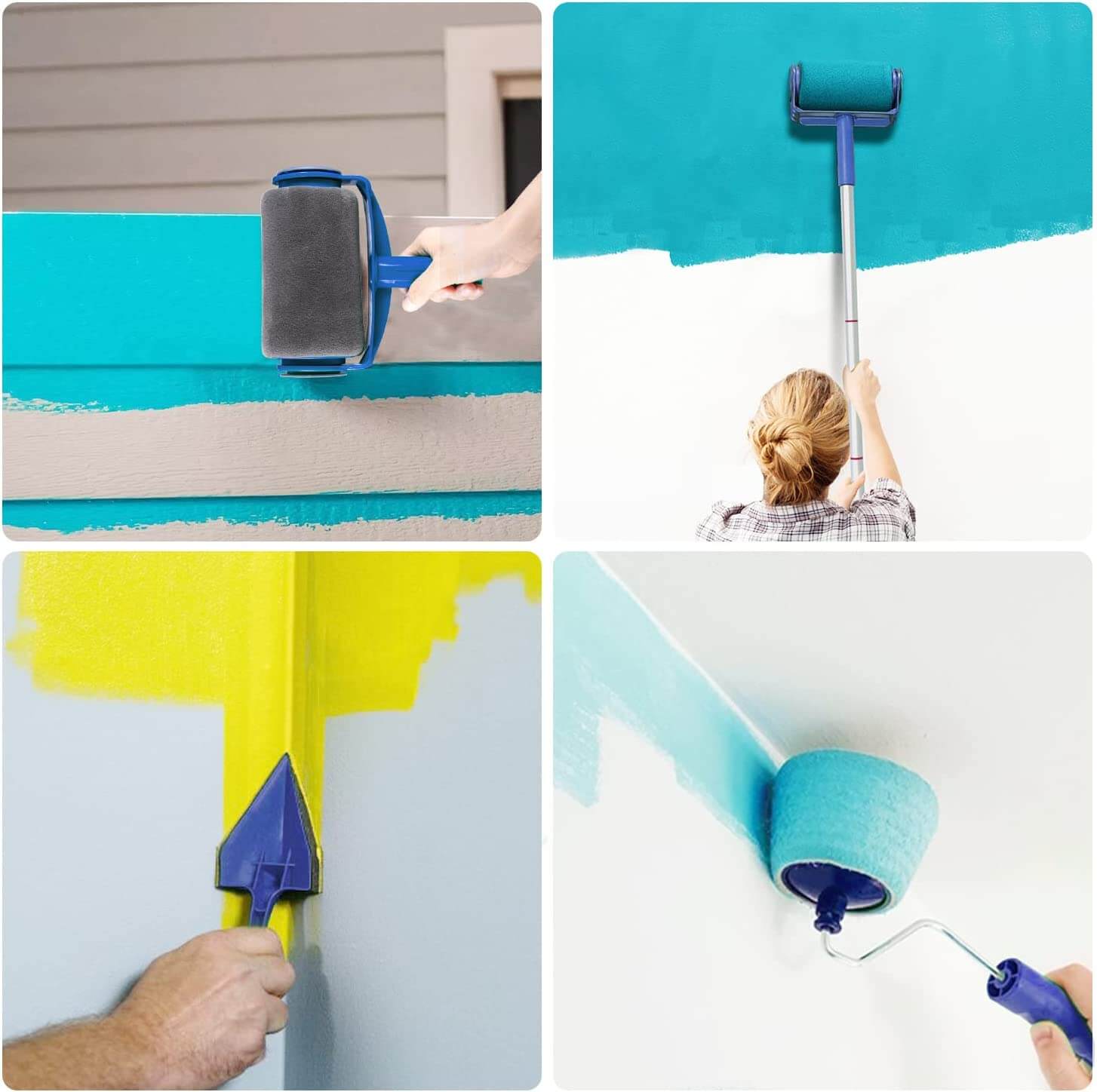What is a Paint Roller that Holds Paint?
 A paint poller that holds paint (paint roller kit) is a tool with a built-in mechanism for pushing paint from the handle to the roller cover. The kit typically includes a roller frame, a roller cover made of synthetic or natural fibers, foam, or microfiber materials, and a handle with a plunger mechanism.
A paint poller that holds paint (paint roller kit) is a tool with a built-in mechanism for pushing paint from the handle to the roller cover. The kit typically includes a roller frame, a roller cover made of synthetic or natural fibers, foam, or microfiber materials, and a handle with a plunger mechanism.
To use this kit, the handle cap is removed, and paint is poured into the handle. The cap is then replaced, and the plunger is used to push the paint from the handle down into the roller cover. This helps to evenly saturate the roller cover with paint so that it can be applied to the surface being painted.
The roller kits are designed to make the painting process more efficient by reducing the need to reload the roller with paint constantly. This can be especially useful for larger painting projects, where reloading the roller with paint can become time-consuming and slow down the painting process.
It’s important to note that roller kits are not always necessary for all painting tasks. They may be most useful for larger painting projects or for more experienced painters who want to work quickly and efficiently. For smaller projects, a traditional paint roller that is manually loaded with paint may be more than sufficient.
Table of Contents
What is the typical capacity of the kit?
The capacity of the roller kit will depend on the specific model and design of the kit. However, in general, the typical capacity of a roller kit ranges from around 4 to 24 fluid ounces (or 0.12 to 0.7 liters) of paint.
Some roller kits may have a larger or smaller capacity than this, so it’s important to check the product specifications before purchasing to ensure they will meet your needs.
Do I really need one?
Whether or not you need a paint roller kit depends on the specific painting task and your personal preferences as a painter. For most projects, no.
If you are working on a small painting project or prefer to manually load paint onto the roller cover using a traditional paint tray, the roller kit may not be necessary.
However, if you are working on a larger painting project or want to increase your painting efficiency, a roller kit may be a useful tool. The plunger mechanism can help reduce the need to frequently stop and reload the roller with paint, speeding up the painting process and making it more efficient.
Ultimately, the decision of whether or not to use a roller kit is up to you. Consider the size and complexity of your painting project, your personal painting preferences, and your budget when deciding whether or not to invest in a roller kit.
Do I need an extension pole?
No. Paint roller kits are not compatible with extension poles. For most roller kits, the handles are usually 3-5 feet long. Others may not be designed to work with one.
Suppose you are considering using an extension pole with your roller kit. In that case, it is important to check the product specifications and compatibility information for the roller and the extension pole to ensure they will work together.

If you have a roller kit that does not have a built-in mechanism for attaching an extension pole, you may need to purchase a separate roller frame that is compatible with an extension pole. In general, roller frames designed for use with extension poles will have a threaded insert at the end of the handle that can be screwed onto the end of an extension pole.
Power Paint Roller vs Paint Roller that Holds Paint vs Paint Rollers
Here is a table comparing Power Paint Rollers, Paint Rollers that Hold Paint, and Traditional Paint Rollers:
| Power Paint Roller | Paint Roller that Holds Paint | Traditional Paint Roller | |
|---|---|---|---|
| Motorized | Yes | No | No |
| Refill mechanism | Automatic | Manual | Manual |
| Continuous painting | Yes | No | No |
| Maneuverability | Heavy | Heavy | Lightweight |
| Cost | Expensive | Moderate | Inexpensive |
| Suitable for | Large projects | Small to medium projects | Small to medium projects |
| Ease of use | Moderate to difficult | Easy | Easy |
| Paint capacity | Large | Moderate | Small to moderate |
| Ideal for | Walls, ceilings, and large areas | Walls and small to medium areas | Small to medium areas |
Note that this table is a general comparison and may not apply to all types and brands of rollers. The specific features and performance of a roller may vary depending on the manufacturer and model.
There are a few key differences between power paint rollers, paint roller kits, and traditional paint rollers:
Power Paint Rollers
They are motorized tools that use a small pump to draw paint from a can or reservoir and deliver it to a roller cover. They typically have a hose that connects the roller to the pump and may also have a built-in extension pole. Power paint rollers can be a faster and more efficient way to apply paint to large surfaces, and they may be more suitable for professional or commercial painting applications.
Paint Roller that Holds Paint
Paint roller kits typically include a roller frame, cover, and reservoir. Some kits may also include additional accessories, such as an extension pole or a separate paint reservoir that attaches to the roller frame. Paint roller kits are often more affordable than power paint rollers and can be a good option for DIY or small-scale painting projects.
Traditional Paint Rollers
Traditional rollers are the simplest, most basic, and most cost-effective option for applying paint to a surface. They consist of a roller cover attached to a roller frame or handle and are typically used with a paint tray or reservoir. Traditional rollers are a good choice for smaller painting projects and for those who prefer to apply paint manually without the assistance of power tools.
Conclusion
The choice between a power paint roller, a roller that holds paint, or a traditional paint roller will depend on the specific needs of the painting project, as well as personal preferences and budget. Power paint rollers can be more efficient but expensive, while traditional rollers are simple and affordable but may not be as efficient for larger projects. Paint roller kits can provide a middle ground, offering some benefits of both options at a more affordable price point.

